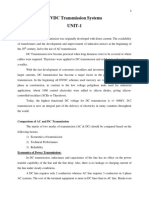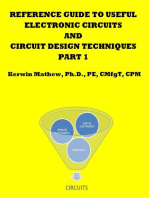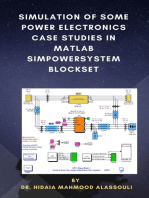Comparison of AC and DC Transmission
Comparison of AC and DC Transmission
Uploaded by
Payal meenaCopyright:
Available Formats
Comparison of AC and DC Transmission
Comparison of AC and DC Transmission
Uploaded by
Payal meenaOriginal Title
Copyright
Available Formats
Share this document
Did you find this document useful?
Is this content inappropriate?
Copyright:
Available Formats
Comparison of AC and DC Transmission
Comparison of AC and DC Transmission
Uploaded by
Payal meenaCopyright:
Available Formats
ROHINI COLLEGE OF ENGINEERING & TECHNOLOGY
1.2 Comparison of AC and DC transmission
The merits of two modes of transmission (AC & DC) should be compared
based on the following factors.
1) Economics of transmission
2) Technical Performance
3) Reliability
Economics of Power Transmission:
In DC transmission, inductance and capacitance of the line has no effect on the
power transfer capability of the line and the line drop. Also, there is no leakage or
charging current of the line under steady conditions.
A DC line requires only 2 conductors whereas AC line requires 3 conductors in 3-
phase AC systems. The cost of the terminal equipment is more in DC lines than in AC
line. Break-even distance is one at which the cost of the two systems is the same. It is
understood from the below figure that a DC line is economical for long distances which
are greater than the break-even distance.
Figure 1.2.1 Relative costs of AC and DC transmission lines vs distance
[Source: “HVDC Power Transmission Systems” by K.P.Padiyar, page-03]
Technical Performance:
Due to its fast controllability, a DC transmission has full control over transmitted
power, an ability to enhance transient and dynamic stability in associated AC networks
and can limit fault currents in the DC lines. Furthermore, DC transmission overcomes
some of the following problems associated with AC transmission.
EE8017 HIGH VOLTAGE DC TRANSMISSION
ROHINI COLLEGE OF ENGINEERING & TECHNOLOGY
Stability Limits:
The power transfer in an AC line is dependent on the angle difference between the
voltage phasors at the two line ends. For a given power transfer level, this angle increases
with distance. The maximum power transfer is limited by the considerations of steady
state and transient stability. The power carrying capability of an AC line is inversely
proportional to transmission distance whereas the power carrying ability of DC lines is
unaffected by the distance of transmission.
Figure 1.2.2 Relative power of AC and DC transmission lines vs distance
[Source: “HVDC Power Transmission Systems” by K.P.Padiyar, page-04]
Voltage Control:
Voltage control in ac lines is complicated by line charging and voltage drops. The
voltage profile in an AC line is relatively flat only for a fixed level of power transfer
corresponding to its Surge Impedance Loading (SIL). The voltage profile varies with the
line loading. For constant voltage at the line ends, the midpoint voltage is reduced for
line loadings higher than SIL and increased for loadings less than SIL.
The maintenance of constant voltage at the two ends requires reactive power
control as the line loading is increased. The reactive power requirements increase with
line length. Although DC converter stations require reactive power related to the power
transmitted, the DC line itself does not require any reactive power. The steady-state
charging currents in AC cables pose serious problems and make the break-even distance
for cable transmission around 50kms.
Line Compensation:
Line compensation is necessary for long distance AC transmission to overcome
the problems of line charging and stability limitations. The increase in power transfer and
voltage control is possible through the use of shunt inductors, series capacitors, Static
EE8017 HIGH VOLTAGE DC TRANSMISSION
ROHINI COLLEGE OF ENGINEERING & TECHNOLOGY
Var Compensators (SVCs) and, lately, the new generation Static Compensators
(STATCOMs). In the case of DC lines, such compensation is not needed.
Problems of AC Interconnection:
The interconnection of two power systems through ac ties requires the automatic
generation controllers of both systems to be coordinated using tie line power and
frequency signals. Even with coordinated control of interconnected systems, the
operation of AC ties can be problematic due to:
1. The presence of large power oscillations which can lead to frequent tripping,
2. Increase in fault level, and
3. Transmission of disturbances from one system to the other.
The fast controllability of power flow in DC lines eliminates all of the above
problems. Furthermore, the asynchronous interconnection of two power systems can only
be achieved with the use of DC links.
Ground Impedance:
In AC transmission, the existence of ground (zero sequence) current cannot be
permitted in steady-state due to the high magnitude of ground impedance which will not
only affect efficient power transfer, but also result in telephonic interference. The ground
impedance is negligible for DC currents and a DC link can operate using one conductor
with ground return (monopolar operation).
The ground return is objectionable only when buried metallic structures (such as
pipes) are present and are subject to corrosion with DC current flow. While operating in
the monopolar mode, the AC network feeding the DC converter station operates with
balanced voltages and currents. Hence, single pole operation of dc transmission systems
is possible for extended period, while in AC transmission, single phase operation (or any
unbalanced operation) is not feasible for more than a second.
Disadvantages of DC Transmission:
The scope of application of DC transmission is limited by
1. High cost of conversion equipment.
2. Inability to use transformers to alter voltage levels.
3. Generation of harmonics.
4. Requirement of reactive power and
EE8017 HIGH VOLTAGE DC TRANSMISSION
ROHINI COLLEGE OF ENGINEERING & TECHNOLOGY
5. Complexity of controls.
Over the years, there have been significant advances in DC technology, which
have tried to overcome the disadvantages listed above except for (2). These are
1. Increase in the ratings of a thyristor cell that makes up a valve.
2. Modular construction of thyristor valves.
3. Twelve-pulse (and higher) operation of converters.
4. Use of forced commutation.
5. Application of digital electronics and fiber optics in the control of converters.
Reliability:
The reliability of DC transmission systems is good and comparable to that of AC
systems. The reliability of DC links has also been very good.
There are two measures of overall system reliability-energy availability and
transient reliability.
Energy availability:
Energy availability = 100 (1 – equivalent outage time) %
Actual time
Where equivalent outage time is the product of the actual outage time and the
fraction of system capacity lost due to outage.
Transient reliability:
This is a factor specifying the performance of HVDC systems during recordable
faults on the associated AC systems.
Transient reliability = 100 X No. of times HVDC systems performed as designed
No. of recordable AC faults
Recordable AC system faults are those faults which cause one or more AC bus
phase voltages to drop below 90% of the voltage prior to the fault.
Both energy availability and transient reliability of existing DC systems with
thyristor valves is 95% or more.
EE8017 HIGH VOLTAGE DC TRANSMISSION
You might also like
- Introduction to Power System ProtectionFrom EverandIntroduction to Power System ProtectionRating: 4 out of 5 stars4/5 (2)
- Econ3510 Sample Final Exam WithanswersDocument10 pagesEcon3510 Sample Final Exam Withanswerssimple975No ratings yet
- Hvts AssignmentDocument12 pagesHvts AssignmentrashmisbhumbareNo ratings yet
- HVDC PDFDocument61 pagesHVDC PDFThulasi PrasadNo ratings yet
- HVDC Transmission Systems UNIT-1: Comparison of AC and DC TransmissionDocument57 pagesHVDC Transmission Systems UNIT-1: Comparison of AC and DC TransmissionSaurabhNo ratings yet
- 229 HVDC Note HVDC Note For 8 Sem Subjects Electrical Engineering All Chapters Include ofDocument58 pages229 HVDC Note HVDC Note For 8 Sem Subjects Electrical Engineering All Chapters Include ofDivyanshu DkNo ratings yet
- 229 HVDC NoteDocument58 pages229 HVDC NoteSubhashree RoutNo ratings yet
- Notes (04 - 01 - 2020 - 729032330)Document62 pagesNotes (04 - 01 - 2020 - 729032330)pearzinNo ratings yet
- HVDCDocument56 pagesHVDCRahul ShakyaNo ratings yet
- HVDC NotesDocument56 pagesHVDC Notesmahi100% (2)
- Comparision of AC and DC TransmissionDocument3 pagesComparision of AC and DC TransmissionPadukolai KarupaiahNo ratings yet
- HVDC - Lecture 1Document17 pagesHVDC - Lecture 1yesmuraliNo ratings yet
- 5 HVDCDocument40 pages5 HVDCghulamqadir.pmpNo ratings yet
- Vemu HVDC NotesDocument125 pagesVemu HVDC NotesDEPARTMENT OF EEE SVEWNo ratings yet
- HVDC Unit 1Document25 pagesHVDC Unit 1leela deviNo ratings yet
- Section B AbdurehmanDocument32 pagesSection B AbdurehmansyabseeshoesNo ratings yet
- DC Power Transmission TechnologyDocument10 pagesDC Power Transmission TechnologyDrVikas Singh BhadoriaNo ratings yet
- HVDC SlidesDocument25 pagesHVDC SlidesAreeb ZulkifleNo ratings yet
- DC Power Transmission TechnologyDocument10 pagesDC Power Transmission TechnologyHARE KRISHNANo ratings yet
- Modelling of HVDC Systems: by Prof. C. RadhakrishnaDocument22 pagesModelling of HVDC Systems: by Prof. C. RadhakrishnaSharath MirididdiNo ratings yet
- HVDC1Document62 pagesHVDC1n anushaNo ratings yet
- HVDC Padiyar Sample CpyDocument15 pagesHVDC Padiyar Sample CpySal Excel60% (5)
- High Voltage Direct Current (HVDC) Transmission Line SystemDocument30 pagesHigh Voltage Direct Current (HVDC) Transmission Line SystemzakiNo ratings yet
- HVDC TransmissionDocument80 pagesHVDC TransmissionKaran SinghaniaNo ratings yet
- HVDC HandoutDocument40 pagesHVDC Handouts.suresh k.swaminathanNo ratings yet
- HVDC Transmission PPT Part 1Document39 pagesHVDC Transmission PPT Part 1srinimeha@gmail.com100% (2)
- HVDC TransmissionDocument78 pagesHVDC Transmissiondhay aliNo ratings yet
- HVDC TransmissionDocument80 pagesHVDC Transmissionsrinimeha@gmail.com75% (4)
- Unit 1 - DC Power Transmission TechnologyDocument23 pagesUnit 1 - DC Power Transmission Technologykarthik0% (2)
- Unit 1Document16 pagesUnit 1prashantpnd07100% (1)
- Lecture HVDCDocument19 pagesLecture HVDCRakibul IslamNo ratings yet
- HVDC TechnologyDocument48 pagesHVDC TechnologyIsrajuddinNo ratings yet
- EHVAC & DC Unit - 1Document91 pagesEHVAC & DC Unit - 1rakesh49r67% (3)
- Starting With The Name of Allah, The Most Beneficient and The Most MercifulDocument32 pagesStarting With The Name of Allah, The Most Beneficient and The Most MercifulEngr Mohsin SaleemNo ratings yet
- EE809 DC-AC System Interactions Lecture - 1Document10 pagesEE809 DC-AC System Interactions Lecture - 1NagababuMutyalaNo ratings yet
- Current Source HVDC Transmission ReviewDocument10 pagesCurrent Source HVDC Transmission ReviewHussam SadigNo ratings yet
- Project 3 - 2xDocument37 pagesProject 3 - 2xSamala NagarajuNo ratings yet
- Rohini 27131066574Document5 pagesRohini 27131066574pradeep kumar shahNo ratings yet
- Ac/Dc Supply SystemDocument10 pagesAc/Dc Supply SystemDHARMESH PARMARNo ratings yet
- Classification of Transmission LinesDocument15 pagesClassification of Transmission LinesJim Erol BancoroNo ratings yet
- Classification of Transmission LinesDocument15 pagesClassification of Transmission LinesJim Erol Bancoro100% (1)
- Analysis and Control of HVDC Transmission Power System: December 2016Document10 pagesAnalysis and Control of HVDC Transmission Power System: December 2016AbhiNo ratings yet
- 1502957399lectrure 5 KUETDocument14 pages1502957399lectrure 5 KUETYashwant ChoudharyNo ratings yet
- Challenges Faced in HVDC SystemsDocument12 pagesChallenges Faced in HVDC SystemsPKNo ratings yet
- UNIT-1 Introduction To Facts: Need For Transmission Networks InterconnectionsDocument13 pagesUNIT-1 Introduction To Facts: Need For Transmission Networks InterconnectionsChetan KotwalNo ratings yet
- L1.Unit-1 19EE307Document39 pagesL1.Unit-1 19EE307Marshmellow FFNo ratings yet
- Comparative Evaluation of HVDC and HVAC Transmission SystemsDocument5 pagesComparative Evaluation of HVDC and HVAC Transmission SystemsNidhiNo ratings yet
- 152 155, Tesma203, IJEASTDocument4 pages152 155, Tesma203, IJEASTAdetunji Babatunde TaiwoNo ratings yet
- Fault Scenario Simulation in A Feeder: Transmission and Distribution of Electrical PowerDocument32 pagesFault Scenario Simulation in A Feeder: Transmission and Distribution of Electrical PowerriteshtiroleNo ratings yet
- 7-Chapter 2 PDFDocument30 pages7-Chapter 2 PDFsirishaNo ratings yet
- Simulation of HVDC Control and Transmission Lines Protection Based On Pscad/EmtdcDocument4 pagesSimulation of HVDC Control and Transmission Lines Protection Based On Pscad/EmtdcMani AshouriNo ratings yet
- Siemens! HVDC Proven TechnologyDocument48 pagesSiemens! HVDC Proven Technologycharlesc5746No ratings yet
- IJETR022506Document5 pagesIJETR022506erpublicationNo ratings yet
- HVDC Proven TechnologyDocument48 pagesHVDC Proven TechnologyMano Paul100% (2)
- Methods for Increasing the Quality and Reliability of Power System Using FACTS DevicesFrom EverandMethods for Increasing the Quality and Reliability of Power System Using FACTS DevicesNo ratings yet
- It Is Quite Another Electricity: Transmitting by One Wire and Without GroundingFrom EverandIt Is Quite Another Electricity: Transmitting by One Wire and Without GroundingNo ratings yet
- Reference Guide To Useful Electronic Circuits And Circuit Design Techniques - Part 1From EverandReference Guide To Useful Electronic Circuits And Circuit Design Techniques - Part 1Rating: 2.5 out of 5 stars2.5/5 (3)
- High Voltage Direct Current Transmission: Converters, Systems and DC GridsFrom EverandHigh Voltage Direct Current Transmission: Converters, Systems and DC GridsNo ratings yet
- Simulation of Some Power Electronics Case Studies in Matlab Simpowersystem BlocksetFrom EverandSimulation of Some Power Electronics Case Studies in Matlab Simpowersystem BlocksetRating: 2 out of 5 stars2/5 (1)
- Aakash FT - 1 - Repeater Course 2021-22 (PH-02)Document26 pagesAakash FT - 1 - Repeater Course 2021-22 (PH-02)Sk jatuu50% (2)
- Tool Box TalkDocument7 pagesTool Box TalkSantosh Kumar MohantyNo ratings yet
- Worksheet A: U-II Engine FamiliarizationDocument6 pagesWorksheet A: U-II Engine Familiarizationbhanuka2009No ratings yet
- KEM-I - 6.75in Sect. - BHA - ATK-eXact+OTK+LTTK - Drlg+Logging - Rev1Document1 pageKEM-I - 6.75in Sect. - BHA - ATK-eXact+OTK+LTTK - Drlg+Logging - Rev1Njoya Simon LeopoldNo ratings yet
- 7 SOCIAL STUDIESzam PDFDocument38 pages7 SOCIAL STUDIESzam PDFNEth TaromaNo ratings yet
- Arrest Log April 3, 2016-April 9, 2016Document5 pagesArrest Log April 3, 2016-April 9, 2016MansfieldMAPoliceNo ratings yet
- 258 - Paul's 1st MissionarDocument2 pages258 - Paul's 1st MissionarNang Mei LiNo ratings yet
- Form 1-2 PhysicsDocument42 pagesForm 1-2 PhysicsRuvimbo NhongoNo ratings yet
- Basic Physics of Digital Radiography - The Source - Wikibooks, Open Books For An Open WorldDocument19 pagesBasic Physics of Digital Radiography - The Source - Wikibooks, Open Books For An Open WorldPravin Kumar MauryaNo ratings yet
- SDYC 2011 Academic BookletDocument124 pagesSDYC 2011 Academic BookletsuhangdageekNo ratings yet
- Post-Workshop Topic10 (Ch12)Document4 pagesPost-Workshop Topic10 (Ch12)DelishaNo ratings yet
- Team Leadership: A Leader Shapes and Shares A Vision Which Gives Point To The Work of Others' (HandyDocument1 pageTeam Leadership: A Leader Shapes and Shares A Vision Which Gives Point To The Work of Others' (HandykkhwahishNo ratings yet
- What Are Eating Disorders?Document1 pageWhat Are Eating Disorders?Wendy CastilloNo ratings yet
- Review ArticleDocument14 pagesReview ArticleARINANo ratings yet
- LP 9 Perdev EmotionDocument6 pagesLP 9 Perdev EmotionJAYDEE GATONNo ratings yet
- Documents You Need To Make A Valid Claim of InsuranceDocument5 pagesDocuments You Need To Make A Valid Claim of InsuranceEkta singhNo ratings yet
- MERCK Use Information Sheet: Exposure Driving Use DescriptorsDocument2 pagesMERCK Use Information Sheet: Exposure Driving Use DescriptorsajoilhamNo ratings yet
- 1000 Calorie MealsDocument5 pages1000 Calorie Mealslotusempire6No ratings yet
- KS3 Chemistry ParticlesDocument19 pagesKS3 Chemistry ParticlesSiriki LohitNo ratings yet
- IU Car Rental SummaryDocument2 pagesIU Car Rental SummaryMurat GülerNo ratings yet
- Canciones de Bhaktivinoda ThakurDocument36 pagesCanciones de Bhaktivinoda ThakurEsteban Ariza RangelNo ratings yet
- Culture Techniquesof Mariine Copepods CMFRIBook CMFRIDocument141 pagesCulture Techniquesof Mariine Copepods CMFRIBook CMFRIBërt RibeiroNo ratings yet
- 0468 Asom20 00TQ 0001 001 BDocument14 pages0468 Asom20 00TQ 0001 001 BDenny AgusNo ratings yet
- Rangeland Ecology and Management (Child, Rawson DennisHeady, Harold F) (Z-Library)Document540 pagesRangeland Ecology and Management (Child, Rawson DennisHeady, Harold F) (Z-Library)flavioNo ratings yet
- Research ProblemDocument33 pagesResearch Problemkiranpatil1014532100% (1)
- ASTM A194 2010a CS and Alloy Steel Nuts For The Bolts - HighPress OR HighTempServDocument11 pagesASTM A194 2010a CS and Alloy Steel Nuts For The Bolts - HighPress OR HighTempServnse mcxNo ratings yet
- COA Elacestrant Dihydrochloride Shandongkehui - 20240120221842Document2 pagesCOA Elacestrant Dihydrochloride Shandongkehui - 20240120221842rashidulhasan789No ratings yet
- Uruguayan Consumers' Perception of Functional Foods: Gastón Ares, Ana Giménez and Adriana GámbaroDocument17 pagesUruguayan Consumers' Perception of Functional Foods: Gastón Ares, Ana Giménez and Adriana GámbaroFibra NurainyNo ratings yet
- World English 3e Level 2 Grammar Activities Unit 1 Lesson ADocument1 pageWorld English 3e Level 2 Grammar Activities Unit 1 Lesson ALaura Valentina VidarteNo ratings yet

























































































